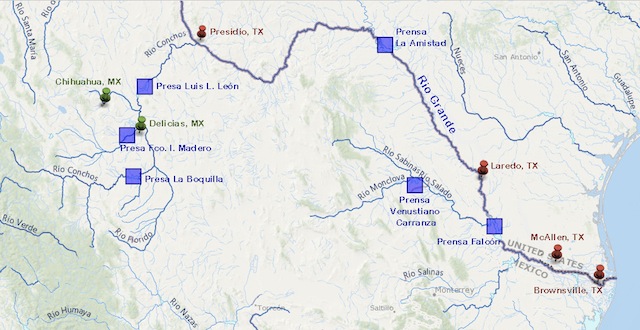 Image credit: Tracy Greer
Image credit: Tracy Greer
Listen to the brief radio segment (4:28) below from The Take Away with John Hockenberry to learn more about water issues on both sides of the border.
While drought is an enduring and pressing issue in Texas, battles over water rights are becoming a standard element of Texas water policy.
In early July, we posted an article explaining how Texas challenged Oklahoma in the United States Supreme Court over claims to water in the Red River. Since much of the water in the Texas portion is too salty for consumption, Texas sought to purchase 150 billion gallons from its neighbor to the north, but Oklahoma refused to sell.
Texas argued that Oklahoma was in violation of the Red River Compact. After Oklahoma denied selling its water, Texas took the case to the Supreme Court alleging that Oklahoma was impeding interstate commerce. In the end Texas lost the court battle, leaving them with the option of either finding additional water elsewhere or implementing stronger conservation measures. Now it seems Texas may find itself in another legal battle for water rights if Mexico can not trim the deficit. As the drought continues and water reservoirs become further depleted, it is likely that Texas could find itself fighting more battles over water-related issues.
Currently, Mexico is falling short of its obligations and not satisfying its portion of the 1944 water treaty signed between the two neighboring countries. In fact, Mexico has not provided the US a full share of water for the last three years, creating a considerable water deficit in the process. With the sustained drought in full effect, narrowing the deficit is becoming increasingly more challenging. The treaty is in place to ensure that both countries receive an allotted amount of water and to ensure that farmers on both sides of the river have sufficient water resources for agricultural purposes. As part of the same treaty, the US supplies the Baja region of Mexico with water from the Colorado river.
According to Sally Spener of the International Boundary and Water Commission, “We basically set aside water in the United States reservoirs that will be released and delivered to Mexico. We do not believe that the Mexican system is managed in a similar fashion.” According to the TCEQ, “The failure of Mexico to consistently deliver water in accordance with the 1944 water treaty between the United States and Mexico significantly harms Texas interests. The treaty requires delivery from certain tributaries in Mexico to the United States of not less than an average of 350,000 acre feet annually, in cycles of five consecutive years. Mexico has failed to deliver the amount of water owed resulting in hardship for Texas water users who rely on that water for irrigation, as well as municipalities that need the irrigation water to convey public drinking water supplies.”
Texas farmers have grown impatient with Mexican officials for not fulfilling their end of the bargain and are asking the US authorities to take a stand. The Texas agricultural industry in the Rio Grande region has been hit hard by the water shortage and some farmers have decided not to plant crops this year. According to an article from Fronteras, “Another year with scarce water could wipe out the farming industry here. A study by Texas A&M University estimates the economic loss would be $400 million and some 5,000 jobs. Cities would also be in trouble since they depend on irrigation canals to deliver their water supply.”
One possible solution for Mexico would be apportioning the Texas supply at the beginning of the yearly cycle, similar to the process the US uses, rather than relying on northern rainfall to fulfill the treaty. It will be interesting to see if Mexico alters its water apportionment policy to supply Texas with the much needed water, or if the deficit will remain due to lack of rainfall and inadequate actions on the part of Mexican officials.
This battle may not have a clear winner and loser in the traditional sense. In the end, we all need rain for survival. Water is an essential element, and there certainly need to be conservation actions implemented on the Texas side if we want our economy (and crops) to continue growing.
Jordan Schmidt 
Editor
jschmidt@banksinfo.com
